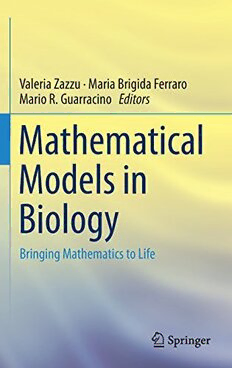
Mathematical Models in Biology: Bringing Mathematics to Life PDF
Preview Mathematical Models in Biology: Bringing Mathematics to Life
Valeria Zazzu · Maria Brigida Ferraro Mario R. Guarracino Editors Mathematical Models in Biology Bringing Mathematics to Life Mathematical Models in Biology Valeria Zazzu • Maria Brigida Ferraro Mario R. Guarracino Editors Mathematical Models in Biology Bringing Mathematics to Life 123 Editors ValeriaZazzu MariaBrigidaFerraro InstituteofGeneticsandBiophysics DepartmentofStatisticalSciences (IGB)“ABT” SapienzaUniversityofRome NationalResearchCouncilofItaly(CNR) Rome,Italy Naples,Italy MarioR.Guarracino HighPerformanceComputing andNetworkingInstitute(ICAR) NationalResearchCouncilofItaly(CNR) Naples,Italy ISBN978-3-319-23496-0 ISBN978-3-319-23497-7 (eBook) DOI10.1007/978-3-319-23497-7 LibraryofCongressControlNumber:2015956528 MathematicsSubjectClassification(2010):92c99,92Bxx,97M10,90B10,90B15,92C42,92B20 SpringerChamHeidelbergNewYorkDordrechtLondon ©SpringerInternationalPublishingSwitzerland2015 Thisworkissubjecttocopyright.AllrightsarereservedbythePublisher,whetherthewholeorpartof thematerialisconcerned,specificallytherightsoftranslation,reprinting,reuseofillustrations,recitation, broadcasting,reproductiononmicrofilmsorinanyotherphysicalway,andtransmissionorinformation storageandretrieval,electronicadaptation,computersoftware,orbysimilarordissimilarmethodology nowknownorhereafterdeveloped. Theuseofgeneraldescriptivenames,registerednames,trademarks,servicemarks,etc.inthispublication doesnotimply,evenintheabsenceofaspecificstatement,thatsuchnamesareexemptfromtherelevant protectivelawsandregulationsandthereforefreeforgeneraluse. Thepublisher,theauthorsandtheeditorsaresafetoassumethattheadviceandinformationinthisbook arebelievedtobetrueandaccurateatthedateofpublication.Neitherthepublishernortheauthorsor theeditorsgiveawarranty,expressorimplied,withrespecttothematerialcontainedhereinorforany errorsoromissionsthatmayhavebeenmade. Printedonacid-freepaper SpringerInternational PublishingAGSwitzerlandispartofSpringerScience+Business Media(www. springer.com) Preface Life scientists are not always fully aware of the powerful role that mathematical models have in both answering biological research questions and in making predictions.Scientists have a clear view of the problem;they knowthe questions; theyhaveidentifiedwaystoanswer;andtheyproducethedatatobeanalysed.Novel highthroughputtechnologiesareutilizedthatgiverisetoanunprecedentedquantity ofdata.However,thedata is‘noisy’,andthe answerto eachquestioncanbe well hiddenunderterabytesofincomprehensibletextfiles. It is here that the mathematicians can help: they know ‘how’ to do things; they love the huge, ugly text files; they foresee hundreds of statistics that could be calculated; they want to try all of them because there is always uncertainty. Mathematiciansseepaths,trends,connections,andcorrelations.Ultimatelytheneed toidentifythebeautifulbiologicalmechanismsthatarehidden,mustcometolight. Indeed,mathematicianstoo,getstuck,lostamongproteinsticks, bubbles,helices, andsheets. During the ‘Bringing Maths to Life’ workshop, held in Naples, Italy, October 27–29, 2014, biologists and mathematicians joined forces to address key areas in biologythatfacedemandingmathematicalchallenges.Alistofinvitedspeakersand participantscamefromleadingEuropeanuniversitiesandtheinternationalscientific community;especiallycomputationalbiologists,mathematicians,andresearchersin thelifesciences.Interdisciplinarydiscussionssurroundedexistingcasesinaneffort toidentifygapsortoshareexistingsolutions.Findingthebestmathematicalresolu- tion to interpret data from a biologicalperspective, or—inversely—understanding the biological issue and its real-life constraints from a mathematical viewpoint, requiredbothcommunitiestocloselyengage.Thepresentvolumegathersanumber ofchaptersselectedfromthemostinterestingcontributionstotheworkshop. The workshop had featured three main sessions. ‘Zoom inside the cell: microscopyimagesprocessing’hadbeenthetopicofthefirstsession.Biological visualization provides the means through which to place genomic and proteomic informationinacellularortissuecontext.Whileexistingsoftwareenablesparticular assaysfordistinctcelltypes,highthroughputimageanalysishas,tothispoint,been impractical unless an image analysis expert develops a customized solution, or v vi Preface unlesscommercialpackagesareusedwiththeirbuilt-inalgorithmsforlimitedsets of cellular features and cell types. There exists a clear need for powerful,flexible tools for high throughput cell image analysis. Computer vision researchers have contributed new algorithms to the project so that their theoretical work can be appliedtopracticalbiologicalproblems. The session on ‘Genetic variability and differential expression: sequence dataanalysis’hadaddressedtherecentrevolutioninDNAsequencingtechnology broughtby the sequencing of an increasing number of genomes. Changes in data quantity and format (large numbers of short reads or pairs of short reads versus relativelylongreadsproducedbytraditionalSangersequencing)implychangesof sequencedatamanagement,storage,andvisualization,andprovideachallengefor bioinformatics. ‘Deciphering complex relationships: networks and interactions’ had dealt with biological systems composed of thousands of different types of components andtheproblemsrelatedtothehugenetworksthatcomprisenumerousnon-linearly interacting dimensions, from which, in turn, biological functions emerge. The networks are far too complex to be understood by the unassisted human mind and therefore to analyze these complex biological systems and to obtain relevant answers, biology requires quantitative models that draw from modern computer scienceandmathematics. Additionally, there had been three invited sessions. The first one was on ‘Molecular Dynamics and Modelling of Protein Structure and Function via High Performance Computing Simulations’ (organized by Alessandro Grottesi from CINECA, Italy). Molecular dynamics simulations are computational tools aimed at studying protein structure and dynamicsas well as protein-proteininter- actions at the atomic level. The high performancecomputingof currentcomputer architectures, as well as the developingof valid force fields for the mathematical modellingof biochemicalinteractions, have providednew tools to help biologists studying and testing hypotheses to understand biochemical phenomena in a new perspective. This session has highlighted the advantages and limitations of this powerfulcomputationaltechnique. Inthesecondinvitedsession,‘Statisticalchallengesinomicsresearchwithin Life Sciences’ (organized by J.J. Houwing-Duistermaat from Leiden University MedicalCenter,TheNetherlandsandLucianoMilanesifromInstituteofBiomed- ical Technologies, CNR, Italy), several statistical issues in omics datasets were addressed,frompreprocessinguptobuildingstatisticalmodelsforjointinterpreta- tionofthedatasets.Thesedatasetscontaininformationaboutdifferentaspectsofthe same biologicalprocesses.Thereforein manystudies, multiple omicsdatasetsare nowadaysavailableandintegratedanalysesofthese omicsdatasetsis theultimate goal to understand biological mechanisms underlying traits. However integration of these datasets is not straightforward since they vary in measurement error distributions,scale, sparsenessandsize. In thissession challengeswere addressed in single omics datasets analysis as well as combined analysis of multiple omics datasets. Preface vii Thethirdinvitedsessionhadbeendedicatedto‘Artificialneuronsandrealistic simulation of neuronal functions’ (organized by Angela Tino from Institute of Cybernetics, CNR, Italy). Modern neuroscience research has generated vast volumes of experimental data, and large scale initiatives launched in recent years will gather much more. Nonetheless, much of the knowledge needed to build multilevel atlases and unifying models of the brain is still missing. Brains are a large network composed of many neurons with their synaptic connections, each expressingdifferentproteinsonthecellmembraneandeachwithitsowncomplex internalstructure.Despite hugeadvances,there is no technologythat allowsus to characterize more than a tiny part of this complexity. The session had shed light on novel solutions from neural-inspired artificial models and software, realistic neuronalfunctionsimulation,and functionaland molecularneurobiologyand had aimedtogatherscientistsfromdiversedisciplinestofosterintegratedapproachesto unravelcomplexbrainfunctions. Naples,Italy ValeriaZazzu Rome,Italy MariaBrigidaFerraro Naples,Italy MarioR.Guarracino Acknowledgments Theworkshophasbeenorganizedby:AlessandraRogato(InstituteofBiosciences and Bioresources); Valeria Zazzu and Enza Colonna (Institute of Genetics and Biophysics); Mario Guarracino (High Performance Computing and Networking InstituteandInstituteforHigherMathematics‘F.Saveri’)fromtheItalianNational Research Council (CNR), Italy; Maria Brigida Ferraro from Sapienza University of Rome, Italy; Martijn Moné from the VU University Amsterdam and ISBE— InfrastructureforSystemsBiologyEurope,TheNetherlands.GerardoToraldofrom theDepartmentofMathematicsandApplications‘RenatoCaccioppoli’,University ofNaplesFedericoII,contributedtotheorganization. The initiative has been supported by the Italian National Research Council (CNR), the Institute for High Mathematics ‘F. Saveri’ (INDAM), the High Per- formance Computing and Networking Institute (ICAR), the University of Naples Federico II, Mimomics, Interomics, the Department of Bio-Agriculture Sciences (CNR),theDepartmentofBiomedicalSciences(CNR),LABGTPandTecnologica. ix
